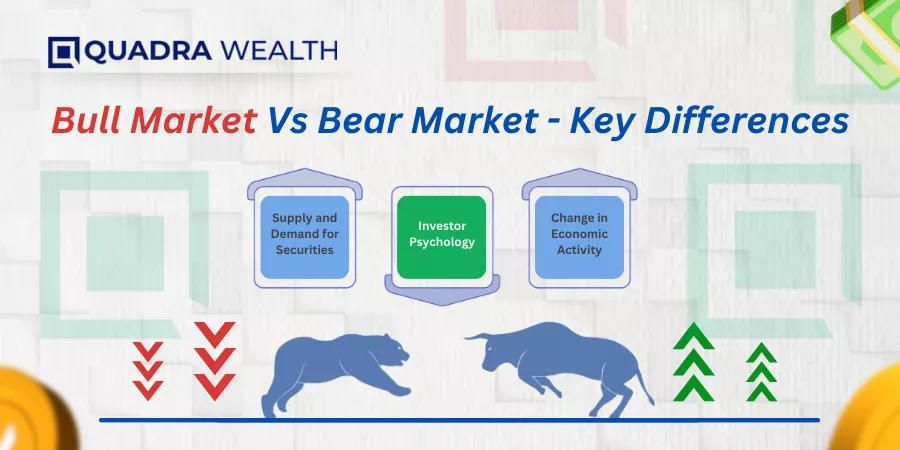Understanding ‘What Does a Bull Market Mean’ is crucial for investors. In a bull market, stock prices rise, the economy grows, and investor confidence increases.
“Bull markets happen when the economy is strengthening, and stock prices are rising,” says Teresa J.W. Bailey, CFP and senior wealth strategist at Waddell & Associates.
While bull markets primarily refer to the stock market, the term can also apply to real estate, bonds, commodities, and currencies. Bull markets also indicate increased consumer spending as wages rise and unemployment rate falls.
Let’s explore what does a bull market mean, how it differs from a bear market, and how investors can benefit from a bull market:
What is a Bull Market?
Wall Street investors use jargon and slang to illustrate the state of the economy and stock market. A “bull market” is a widely used term stock traders use to demonstrate a long, extended period when stock prices get higher and investors’ viewpoint is optimistic.
Regular retail investors can take advantage of bull markets by investing with one of the best stock trading apps that provide fee-free trades and longer market trading hours. During this time, consumers seem to be more optimistic about the future and become ready to spend as investors become confident like bulls.
The term “bull market” describes the manner of how a bull attacks with the term “bear market” following the same line of thinking. Bulls fling their heads up, indicating how confidently investors “charge” the market. On the other hand, bears swoop down on their prey.
Measuring Bull Markets
Bull markets are generally a continuous increase in major market indexes like the S&P 500, Dow Jones, and Nasdaq. As a general rule, the stock market experiences a bull market run of 20% rise in price from the market’s most recent low. This increased price symbolizes that prices tend to grow continuously and it’s the best time to benefit from bull markets.
That said, understanding bull markets can influence any asset class, involving bonds, sticks, real estate, gold, cryptocurrency, and digital currencies.
Characteristics of a Bull Market

A bull market is characterized by the following features:
High Investor Confidence
As asset values continue to rise, traders remain confident that prices will keep increasing. In simple terms, investors feel more optimistic which triggers them to buy more, expecting increased returns.
Rising Prices
A larger bull market time period offers easy spending due to improving conditions. Higher wages increase customers’ spending power, resulting in higher demand for goods and services. After all, it gives the impression of getting more money easily.
Ultimately, it can fuel inflation because the increased wages and easy spending will lead to increasing prices of goods.
Economic Expansion
During this market boom, more businesses bet on their future, fueling economic expansion. Encouraged by consumer buying, companies pay attention to expansion and invest in themselves.
Declining Unemployment Rates
Joblessness rates consistently go down during bull markets. As businesses and companies expand, they recruit more employees, thus mitigating unemployment. Average salaries also increase as enterprises struggle to attract competent staff. Workers are also looking for better opportunities that can offer them even higher wages than their current job.
Why Do Bull Markets Happen?
A bull market generally coincides with the economic improvement from higher consumer spending, strong corporate earnings and improved business strategies. As a result of increased purchases of goods and services, companies are able to generate more income, offer jobs, and allocate funds to emerging technologies in this expansion phase.
If businesses generate more revenue, investors can feel more confident about their business performance, and hence, the larger economy. These financiers may be inclined to invest in assets like real estate and stocks, taking advantage of the improving business conditions.
The higher the revenue, the greater the duration of market optimism. However, as production and purchasing levels grow, the prices of goods and services can also increase. Again, too much inflation can hamper economic stability.
Another crucial factor that could contribute to the inception of a bull market is policy changes. For example, if a new government assumes control of a country, it could enforce legislative changes that are more beneficial for businesses.
Such optimistic market trends lead to robust economic growth, inspiring investors to invest in volatile assets like stocks. If a new government reduces interest rates, cuts taxes or mitigates regulation, this market boom can fuel financial market growth and greater investor optimism.
How to Identify a Bull Market?
You can recognize a bull market depending on:
Continuous Rise in Stock Prices
A key indicator of a bull market is a sustained rise in stock prices, driven by economic growth and strong enterprise growth. When the value of these securities continues to grow, investors frequently feel confident that this market uptrend will persist. It encourages them to buy more of these assets.
High Investor Demand
Another clear indication of a bull market is high investor demand. When asset prices pursue an upward market trend, investors expect the best about their future price direction. They get motivated to purchase more stocks, hoping for an attractive return on their original investment. This, certainly, results in additional gains in asset values.
How Long Does a Bull Market Last?
An average duration of bull markets is 5.5 years, and the longest bull market began in 2009 and ended in 2020. That said, no two bull markets are identical. So, making precise predictions about a bull market is almost impossible.
As an old saying goes, bull markets don’t die of old age. A bull market might change by experiencing fundamental market changes. For example, when prices increase too fast or high, or some other factors collapse investor confidence.
As it is impossible to notify when a market has reached its climax from a ground level perspective, it is hard to predict the turning point until you are in it. However, investors still try to predict market peaks and downturns.
“Markets move quickly,” Bailey says. “Historically, we’ve seen markets move as much as 9% or 10% in one day.
Differences Between Bull and Bear Markets

Although the stock price trends symbolize a bull market or bear market condition, there are some associated features that investors should keep in mind.
Supply and Demand for Securities
A bull market as a whole is a broader market that has low supply and strong overall demand for stocks. In simple terms, many investors want to buy and hold securities, but few are ready to sell them in this expansion phase of the business.
Consequently, it contributes to the rise in share prices as investors strive for better economic conditions.
In a bear market, the contrary is true as stock prices fall. More people are struggling to sell than purchase. Demand is considerably lower than supply, and, therefore, share prices fall.
Investor Psychology
Market behavior is shaped by investor perception and reactions. It also impacts investor psychology whether the market is going to rise or fall. Both investor psychology and stock market performance depend on each other. Investors can profit from bull markets by investing in stock market sector and others.
While in a bear market, the market sentiment is negative. The capitalists tend to withdraw their money out of equities and move into fixed-income securities as they wait for a positive wave in the stock market.
Briefly speaking, the drop in stock market prices and economic contraction decline investor confidence. This urges investors to keep their money out of the market, which, as a result, leads to general price drop as outflow increases.
Change in Economic Activity
Because the enterprises whose stocks are marketed on the exchanges are contributors to the greater economy, the stock market and the economy are strongly connected.
A bear market usually is linked with a weak economy. Most companies are unable to report great benefits because customers are not spending nearly enough. This fall in profits directly impacts the way that the market values stocks.
In a bull market often the opposite happens. Consumers have more money to spend and are ready to spend it. As share prices are expected to rise and that fuels and empowers the economy.
The Bottom Line
A bull market may coincide with a tendency in a financial market featured by investor optimism and rising prices. It can happen in the stock market as well as in the commodity, currency, real estate, and bond markets.
Bull markets tend to last longer than bear markets and are characterized by declining unemployment, increasing corporate profits and GDP, and rising demand for securities. The reverse of a bull market is a bear market, which is marked by investor pessimism and falling prices.
If you plan to invest in the market, understanding “What Does a Bull Market Mean?” is essential. Quadrawealth can provide you with more efficient trading strategies helpful to achieve your financial goals. Now is the best time to learn market trends and upscale your business. Contact us today and start your investment journey!
FAQs
Q1. Can a Bull Market Be Predicted?
A: One can’t predict exactly when a bull market can occur, but it is expected to happen after a downturn or recession in the market. Indications that the market is on an economic bull run involve higher stock prices, increased consumer spending, optimistic investor sentiment, and the overall economic growth.
Q2. Is a Bull Market Good to Put Money into?
A: Bull markets are typically a good time to invest in stocks. However, investors should assess the value of stocks they intend to buy instead of simply examining the upward market trend.
Q3. Do Bull Markets End?
A: Yes, bull markets end. The end of a bull market is when the upward trend is followed by a bear market (a drop of at least 20%), or a correction (a 10% drop). Bear markets are usually shorter than bull markets. However, the extended period of time of a bull market in history is 5.5 years.






